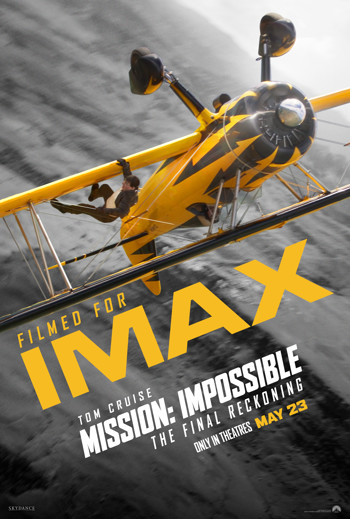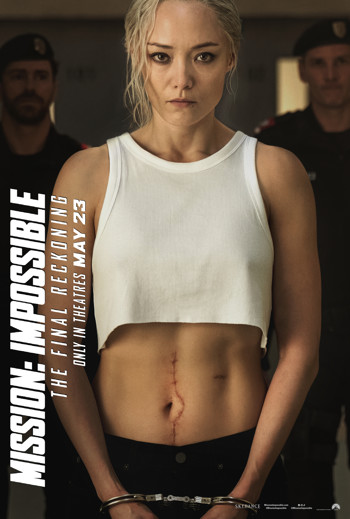Movies

New Releases • A-D • E-H • I-P • Q-Z • Articles • Festivals • Interviews • Dark Knight • Indiana Jones • John Wick • MCU
In the air, underwater and in the Arctic: Go behind the scenes of The Final Reckoning with Tom Cruise and writer-director Christopher McQuarrie
Three featurettes: Paramount Pictures
Mission: Impossible – The Final Reckoning
Directed by Christopher McQuarrie
Rated PG-13
Accepted 23 May 2025
#MissionImpossible • #IMAX
The duo of Cruise and McQuarrie light the fuse for a sizzling conclusion (supposedly) to this enduring theatrical series.
St. Matthew Island

"Timing is everything."
It’s a theme running throughout the decades-long series of Mission: Impossible adventures on screens big and small. But it’s also a significant line of dialogue that serves as a refrain in Final Reckoning, an adventure in which the fate of the entire world and all of humanity is in the balance. Time is running out as the infamous fuse burns down to the late, great planet Earth.
The stakes don’t get any bigger.
And timing is everything.
In this eighth big-screen adventure, star Tom Cruise and director Christopher McQuarrie play with time and bend it to their will. This is a movie that runs 11 minutes shy of three hours. The opening credits don’t appear until 25 minutes into the movie — and when they do appear, they flash across the screen quickly.
It’s been expected this will be Cruise’s last outing as Ethan Hunt and the movie most certainly feels that way, although oddly enough more so at the beginning than at the end. Those opening minutes include a montage of flashbacks to previous Ethan Hunt escapades, something that doesn’t seem all that necessary. Padding isn’t required in a nearly three-hour capstone, even when a significant, climactic action is anticipated to take merely 100 milliseconds.
While it’s a slow-burn kind of start, The Final Reckoning (no longer Dead Reckoning: Part Two) churns and churns as it brings in characters or references to them dating back to the very first Cruise episode released on 22 May 1996. Even that specific date plays into the narrative in a very significant way.
Meet Me in Trafalgar Square
Sure, there are a couple phenomenal action set pieces, as would be expected from Cruise and McQuarrie, and his co-writer, Erik Jendresen. But they also throw in a left hook that lands quite a punch. There’s a message in this movie, a rather profound one, that revisits Ethan’s actions from the past movies and recasts them in a diabolical narrative bow that ties the entire series together.
Yes. That’s right. "Diabolical." It’s quite an accomplishment that gives this movie the extra edge it needs to look past its own small collection of cinematic sins.
And it all starts with a compelling mission for Ethan Hunt, should he choose to accept it: surrender.
But, come on, this is Ethan Matthew Hunt. Even a message directly from the President of the United States (Angela Bassett, Black Panther) isn’t enough for this rebel with a cause to turn himself in. He’s a rule-breaker whose efforts are never fully appreciated, particularly by those who assign the missions then get in the way of their being accomplished.
When M. Night Shyamalan revisited Unbreakable with the sequels Glass and Split, he attempted to make a trilogy nobody knew they wanted (and, by and large, they didn’t). That strategy didn’t work.
Here, there’s a haunting approach to the narrative that pulls elements from the prior episodes and wraps them in a theme about how each of us are the sum of our life choices. And some of those seemingly "right" choices can lead to dangerous unintended consequences. It’s a motif introduced in Dead Reckoning and it’s remarkable to say this about a series that started out with loads of kitsch and vanity, but Final Reckoning reaches a lofty level of timely gravitas. And a huge chunk of that sensation stems from events in M:I:3, a pretty bad movie on its own.
In this context, though, there are a few thoughts — a few minutes — that give that episode a reason for existing.
It Is Written
Final Reckoning runs a little too heavy-handed at times. It lacks the goofy, humorous moments — those Fiat moments from Dead Reckoning — that help break the tension and it at times feels restrained by the score from Max Aruj and Alfie Godfrey. The two, both from the "school" of Lorne Balfe and Hans Zimmer, focus on the ominous, dour bits from Balfe’s Dead Reckoning score and skimp on the ever-energizing theme by Lalo Schifrin.
As the movie opens, it’s noted the world is changing. Truth is vanishing.
A-men to that. (And not in a good way.)
The Entity introduced in Dead Reckoning wants to control the truth and — by way of some questionable cyber babble — destroy the world as doomsday cults fall under its persuasive sway. There’s also something about the destruction of cyberspace which hurts the head if thought about too much. So. Don’t.
Ethan’s mission, then, is to find the source code. Lordy. Source code has never sounded more dangerous and — gosh — kinda sexy as it does here. If only.
Staying true to their tricks, Cruise and McQuarrie once again keep the masks to a minimum. They’re early. They’re quick. Good.
But there is one nagging bit of trickery in their narrative bag that’s oddly fascinating and also distracting: carefully choreographed conversations in which one person after another speaks without any sense of interrupting the conversation while continuing a single line of reasoning from voice to voice, from one corner of the room to another. It’s uncanny and this author has never, ever experienced such a remarkably smooth and cogent conversation including maybe a half-dozen or so participants. Never. Ever. In a way, it’s a rebellious response to the old school monologue, a notion that got burned in The Incredibles when Syndrome went on his... well... his long-winded monologue.
Both are a nefarious narrative device until they’re noticed. Then they’re both a little grating.
Nothing Is Written

In the typical movie, those are the kinds of nits that can bring a movie down a notch or so.
But that’s where those remarkable action set pieces come into play and totally blow the mind. And they’re done big in IMAX.
Ryan Coogler brought some nice artsy touches to the IMAX experience in Sinners. Here, McQuarrie also plays with the aspect ratio shifts. In particular, there’s a slick — almost imperceptible — shift done while Ethan turns a water valve on a submarine. As he turns the valve, the screen expands to full IMAX and leads into a lengthy, thrilling underwater sequence.
Ah. Then there’s the capstone set piece in this capstone episode. It’s a phenomenal aerial sequence involving a couple biplanes. The biplane hasn’t received much on-screen love since Indiana Jones crashed one and was humorously passed by another in a tunnel in The Last Crusade.
Here, as has been widely promoted, Cruise did his own stunts, fittingly in an outfit that’s effectively a modern spin on Indy's favorite fashion statement. And watching his breath being taken away is actually quite breathtaking as he clings to the outside of one biplane, then commandeers it and swoops in on another. This is wildly adventurous moviemaking. This is part of Cruise and McQuarrie’s master plan to get people off their sofas and bring them back into the theatre for a communal thrill ride in which audience reactions are part of the fun.
We’ll Figure It Out
It’s a triple-threaded climax that follows in the popcorn-strewn narrative strategy George Lucas leveraged in Return of the Jedi. That exhilarating plane sequence is only one of the challenges. There’s Ethan in the air, balancing the aerobatics while confronting Gabriel (Esai Morales, Titans), compounded with the need to nest one cyber device in another. But there’s also Benji (Simon Pegg, The World’s End), Paris (Pom Klementieff, Guardians of the Galaxy) and Grace (Hayley Atwell, Captain America: The First Avenger) simultaneously trying to keep Benji alive while also grappling with a tight timeline to capture the Entity.
And there’s another trio with their own mission to fulfill.
It’s all classic summer movie stuff. Delivered at the right time.
As for Cruise, with his longer, unnaturally dark hair, there’s something more agreeable about him now, a guy who’s looking at turning 63 in July and wearing all the mileage quite well.
It seems so appropriate, then, that one of the ideas of empowerment running through this chapter is about willing the future into being. Maybe time will finally catch up with Cruise. But not yet.
• Originally published at MovieHabit.com.


